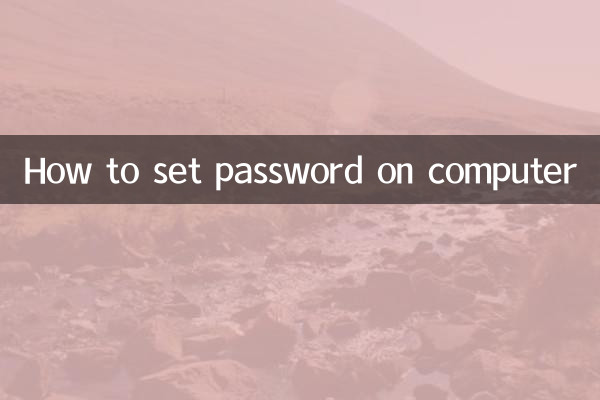How to set password on computer
In today's digital age, protecting personal privacy and data security has become particularly important. Setting a password for your computer is one of the most basic security measures. This article will introduce in detail how to set a password for your computer, along with recent hot topics and hot content, to help you better understand current network trends.
1. Recent hot topics and hot content

The following is a summary of hot topics and content on the Internet in the past 10 days:
| hot topics | Hot content | heat index |
|---|---|---|
| Artificial Intelligence Technology Breakthrough | OpenAI releases GPT-4o, greatly improving multi-modal capabilities | ★★★★★ |
| Technology product launch | Apple WWDC 2024 releases iOS 18 and new AI features | ★★★★☆ |
| Cyber security incident | Multiple data breaches around the world have drawn attention | ★★★★☆ |
| social hot spots | College entrance examination results are announced one after another in various places, and volunteer application forms have become the focus | ★★★☆☆ |
| entertainment gossip | A certain celebrity’s wedding sparked heated discussions across the internet | ★★★☆☆ |
2. Steps to set password on computer
Setting a password for your computer can effectively prevent unauthorized access and protect your privacy and data security. Here are the detailed steps for setting a password on Windows and macOS systems:
1. Set password on Windows system
| step | Operating Instructions |
|---|---|
| Step 1 | Open Settings > Account > Sign-in Options |
| Step 2 | Click "Add" in the "Passwords" section |
| Step 3 | Enter new password and confirm, set password reminder (optional) |
| Step 4 | Click "Next" > "Finish" to save settings |
2. Set password on macOS system
| step | Operating Instructions |
|---|---|
| Step 1 | Open System Preferences > Users & Groups |
| Step 2 | Click the lock icon in the lower left corner and enter the administrator password to unlock |
| Step 3 | Select the current user account and click "Change Password" |
| Step 4 | Enter old password (if any), set new password and verify |
| Step 5 | Click "Change Password" to complete the settings |
3. Password setting suggestions
To ensure password security, it is recommended to follow the following principles:
| suggestion | illustrate |
|---|---|
| length | At least 8 characters, more than 12 recommended |
| complexity | Contains uppercase and lowercase letters, numbers, and special symbols |
| uniqueness | Do not share the same password with other accounts |
| Regular replacement | Change your password every 3-6 months |
| Avoid personal information | Do not use birthdays, names and other information that can be easily guessed |
4. Recommended password management tools
Remembering multiple complex passwords can be difficult, so consider using a password management tool. Here are a few popular password managers:
| Tool name | Features | Support platform |
|---|---|---|
| LastPass | The free version is fully functional and supports multi-device synchronization. | Windows/macOS/iOS/Android |
| 1Password | Friendly interface and high security | Windows/macOS/iOS/Android |
| Bitwarden | Open source and free, you can build your own server | Full platform support |
| KeePass | Local storage, high security | Windows (there are third-party clients for other platforms) |
5. Frequently Asked Questions
Q1: What should I do if I forget my computer password?
A1: Windows systems can be reset using the reset password tool or using an administrator account; macOS can be reset using the Apple ID or using recovery mode.
Q2: What should I do if the boot becomes slow after setting a password?
A2: This is a normal phenomenon and the system needs to verify the password. If the delay is too long, you can check the system startup items or consider upgrading the hardware.
Q3: Which is more secure, fingerprint recognition or password?
A3: Fingerprint recognition is more convenient, but password is theoretically more secure. It is recommended to use it in combination, setting a password and enabling biometrics at the same time.
6. Summary
Setting a password for your computer is an important step in protecting your personal information. With the method introduced in this article, you can easily set a secure password for your Windows or macOS system. At the same time, combined with secure password management habits and tools, you can better protect your digital assets. In today's environment of frequent cybersecurity incidents, developing good password habits is more important than ever.
Finally, I would like to remind everyone that when setting a password, you must not only consider security, but also ensure that you can remember it. Overly complex passwords may reduce security if they result in frequent resets. Only by finding the balance between security and convenience can password protection truly play its role.

check the details

check the details